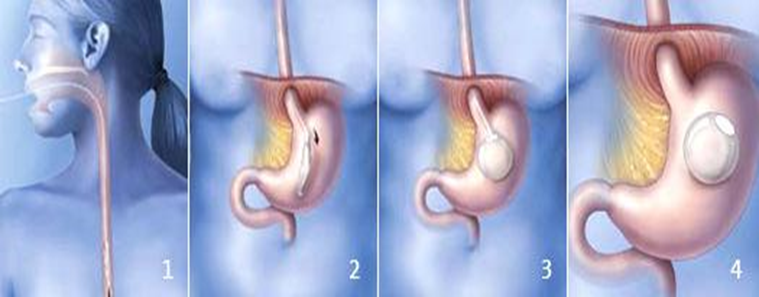
The intra-gastric balloon is a silicon balloon about the size of a large grapefruit which is filled with saline. It sits in the top of the stomach and helps to limit the amount of food you can eat by making you feel full.
- It is inserted by an endoscopic procedure performed in theatre under sedation or light general anaesthetic, normally as a day case procedure. This means no incisions are necessary. The balloon is passed through your mouth and down into your stomach using an endoscope (a thin, flexible tube that has a light and a camera on one end).
- The balloon needs to be removed after 1 year
- A few people do not tolerate the balloon very well and may need to have it removed early, but most people do very well and will lose between 20-30% of their excess weight over the 6 month period.
The Program
Although you will have a feeling of fullness and your stomach capacity will diminish, that alone is only part of the program. Your doctor along with a dietician/behavior modification specialist will meet with you during the course of the implantation period to help you modify your eating behavior. Food choices and lifestyle modifications will be easier to enforce with the gastric balloon balloon in place. Compliance with this program and at least once monthly visits with your dietician/behavior modification specialist will enhance your ability to succeed and maintain weight loss after the balloon is removed.
How is the intra-gastric balloon procedure performed?
A standard endoscopy with sedation is performed. If no abnormalities are found, the balloon is inserted via the mouth into the stomach – all under sedation. Once take approximately 10 minutes, after which patients are monitored for approximately 1 hour and then sent home.

For whom is the intragastric balloon suitable?
The intra-gastric balloon is designed to assist with weight loss in people who have approximately 10 kilograms or more of weight to lose, or those individuals with a BMI > 27, or are not suitable candidates for weight loss surgery. The use of the balloon may assist in reducing weight prior to any surgery, thereby diminishing operative risk.
Gastric balloons are often used as a short-term solution, which is why having one fitted following pregnancy is becoming more commonplace. The results can vary, but women can expect to lose in the region of 10-20kg in the first six months, meaning that the average amount of weight gained during a pregnancy can be shed long before your newborn says its first word.
How long does the Balloon stay in the stomach?
The Balloon depend on the type of balloon used, can remain in the stomach for 6 months to 1 year. While you are using the balloon, your doctor will prescribe a course of oral medication to reduce your stomach acid (this will reduce the possibility of gastric ulcer).
How much weight can I lose with the gastric balloon?
It is important for you to understand that the intra-gastric balloon is a tool to aid weight loss and must be used in conjunction with diet, exercise and a behavior modification program. The amount of weight you lose and maintain will depend on how closely you follow your diet and adopt long-term lifestyle changes. Average weight losses of 12 to 15 kg over 6 month periods have been reported with intra-gastric balloons. The Spatz balloon patients have reported an average of 25 kg weight loss at 12 months in clinical study.
What are the possible side-effects associated with the intra-gastric balloon?
It is very likely that the presence of the balloon in the stomach will cause nausea, vomiting or abdominal pain, of varying intensity, for several days after placement. Your docrtor will prescribe medication to help minimize these potential effects, but these can persist during the first week. There exists the possibility that you will lose only a small amount of weight or lose no weight at all while using the balloon.
Of course, your commitment to dietary and behavioral changes will determine your success.


